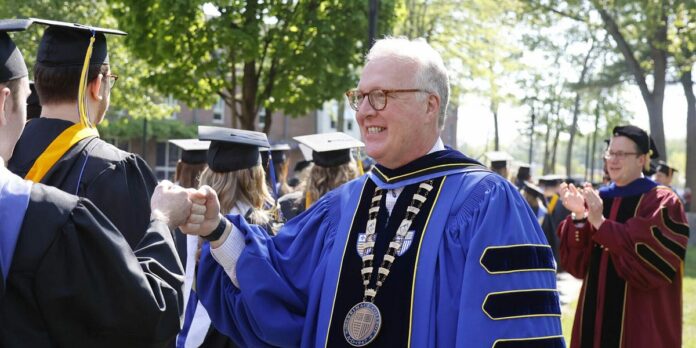The House v. NCAA settlement, which could be approved as early as next month, will change the world of college athletics.
The settlement will usher in sweeping changes. Perhaps the most significant is it will grant the schools the ability to directly share revenue with student-athletes. Other changes include the removal of scholarship limits and the institution of roster caps across all sports.
Under the terms of the settlement, Power Four schools (Big Ten, ACC, Big 12, SEC) are required to opt-in to this new tier of Division I. All other Division I schools are given the option to opt-in, or remain under the current Division I guidelines.
Merrimack announced last week that it will opt-in to the House settlement. But the process of arriving at that decision started almost two years ago, as college president Dr. Christopher Hopey explained.
“Internally, as a college, we’ve been having conversations about NIL, the transfer portal, and NCAA issues for more than two years,” Hopey told The Mack Report last week. “How do we compete in that world? We started a collective last year with the help of some alumni. So, we’ve already been dipping our hands into that pool for a while. As part of those conversations, we’ve talked about increasing our investment in those areas. We looked at Alston money. Ultimately, opting in was a pretty easy conclusion.”
Schools will be allowed to share up to $22 million per year with student-athletes, but schools are not required to share that amount of revenue. Individual schools can determine what they can afford to share.
“If it meant we needed to revenue share $20 million, nobody would be opting in other than the power conference schools,” Hopey said.
Hopey believes this decision will help the college continue to reach its competitive goals. Specifically, he said the college wants to be Top 150 in basketball and Top 30 in hockey.
Merrimack is already extremely close to reaching those goals in those sports. Men’s basketball finished the season No. 182 in the NCAA NET ranking and men’s hockey finished the season No. 31 in the NCAA Pairwise rankings.
The competitive structure of the MAAC will help the Warriors continue to reach for a Top 150 ranking. Men’s hockey was a Top 30 team in 2022 and 2023 and has finished just outside the Top 30 (No. 35, and No. 31) the last two seasons.
“We’re already accomplishing those goals,” Hopey said. “When you look at hockey, and who we are competing with, we need to revenue share to be competitive in Hockey East. If you want to win and compete, like we do, then you have to play the way the big boys play. That’s been the mentality since the day I came here.
“We’re taking the same approach academically. That’s why we are expanding into research. Being a small liberal arts school isn’t survivable anymore. Being a major research university, with a major D-I athletic program, that’s where we’re headed, and really, we’re there now.”
Competitively, House could create two tiers of Division I athletics: the opt-in schools and the opt-out schools. The championships are not being split. Opt-in schools will compete with opt-out schools, sometimes in the same league.
For example, not every MAAC school will opt-in. Sources told The Mack Report that “approximately half the league is planning on opting in.” In Hockey East, Boston College is required to opt-in as a Power 4 school. Northeastern and UMass have confirmed their intentions to opt-in. UConn and Providence have not made formal announcements but are expected to opt-in because of their status as major college basketball schools. Maine, New Hampshire, UMass Lowell, and Vermont have not publicly announced intentions as of this writing.
“We left Division II because I felt it was no-man’s land,” Hopey said. “You give some scholarships, but you only play regionally, and you get no brand. It didn’t make sense for us to continue down that path. In many ways, this is the same thing. We want to win. We want to be competitive.”
It’s all part of a bigger strategy for growth. Applications have skyrocketed in recent years; Merrimack annually sets application and enrollment records.
The college’s “Togher We Rise” campaign has raised $64.5 million out of a $100 million goal.
“It’s been 15, going on 16 years for me here, and it’s exciting to think about what Merrimack could look like in the next 10 or 15 years,” Hopey said. “There’s no reason why we can’t continue to grow. We have big goals, and not all of them will happen in my time as president, but we’ve set the course. The things we are doing will transcend presidents, trustees, and faculty. It’s about putting the college on that trajectory, and we’re doing that, which will make the growth pretty natural.
“We just needed to make sure that the dynamics worked for us. If you had to commit to $20 million, we wouldn’t be doing it. Neither would a lot of schools. But competitively, to continue to grow our programs and to continue to grow as a college, this was the logical step for us. It wasn’t a hard decision.”





















